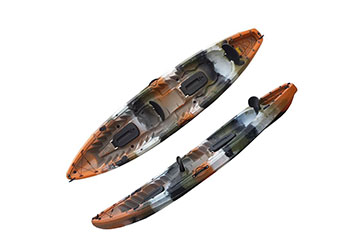7 Things You Need to Know Before Buying a Fishing Kayak

Fishing Kayaks are the hottest thing since sliced bread in the Fishing industry right now. From freshwater to salty water to north and south, you would not be able to enter and leave tackle stores, sporting goods stores, or online forums without seeing things related to chasing small fins from Fishing kayaks.
There is a reason for the proliferation of Fishing Kayaks, which are more stable than canoes, more portable, and much cheaper than traditional powered Fishing boats. They are also very friendly, providing countless more access points for downtown anglers.
In response to their popularity, the kayaking industry has grown dramatically -- there is now PINO TECHNOLOGY that produces high-quality, fished kayak manufacturers, and we have designs for everything from the tiniest streams to the open ocean.
Competition is huge for consumers, but it can also lead to confusion - how to find the kayak that best suits their needs through all the options on the market?
The first step is to determine exactly what these requirements are, and the following tips will help you.
1. The length of the fishing kayak
The length of a fishing kayak has a significant impact on its water performance.The first step in determining the required length is to consider the type of water to use.In general, shorter kayaks (less than 11 feet) are easier to handle, while longer kayaks (more than 12 feet) are faster.If your local water area consists mainly of small ponds, streams, and stagnant water, choose mobility over speed.If you are going to fish in a larger lake, river or ocean, choose a longer model.It's also important to incorporate your body size into the equation.If you're 6 feet 5 feet tall, that's 290 pounds -- no matter how much water you fish, you probably don't want to go under 11 feet.
2. Kayak stability is key
Although canoeing in the past was surprisingly unbalanced and unstable, many of today's fishing machines are stable enough to stand up, which was previously unheard of.For fishing, stability is the most important, but too many factors can make kayaking less maneuverable and more difficult to paddle effectively.If your body is larger, plan to stand up to fish or regularly go to smaller ponds and rivers, then choose a wider, more stable model.The narrower, less stable version is easier to paddle and is ideal for towers and anglers who can cover large amounts of water in a day.
3. Maximize storage
As a fisherman, it is important to find a Large capacity fishing Kayak that has enough space to accommodate all the necessities.Some models have integrated storage, even Live Wells. Others have molded areas for external storage, such as milk crates and coolers. The seated model usually has a molded internal hatch, while the seated model has more open space in the hull for storage of equipment. Write down a list of all the items you're likely to have with you while fishing and visualize where you'll put them before you buy.
4. Keel or no keel?
The keel is a "fin-like" piece of plastic that plunks down from the hull of the kayak into the water and improves tracking and speed.Some canoes have integrated keels, some have retractable keels, and some do not.If you are fishing in open water, towing, or want to stay in fairly deep water, choose the keel model, as it will allow you to paddle more efficiently.If you're floating in shallow rocky rivers, fishing at close range, or enjoying fishing, don't expect anything more.
5. Electronic room?
Many specific "fishing canoeing" models, such as the "Fisherman For Life" canoeing on the market, have been made to adapt to modern electronics.If you fish in many lakes or oceans, you may want to consider this.If you're floating shallow rivers, you can probably do just as well without.
6. The portability of fishing kayaks
All the advances in canoeing today in terms of fishability, stability and storage have made them heavier than ever before.Take this into account in your research.If you plan to transport kayaks into uncharted (and unfished) waters on a regular basis, you may need something light and easy to tow to the lake.If you want to go straight from the truck to the water, please always load the gear and accessories.Usually, when buying a fishing kayak, a mount is much heavier than a mount.
7. Anchor or drift
If you're fishing with kayaks in open water or even back water where you might want to anchor fish, adding a traditional or electronic anchoring system such as a PowerPole Micro can be a huge benefit.But they also add weight and may not be necessary for anglers who like to drift with the current while fishing.Do your homework, because there are several anchoring methods to meet all budgets.










